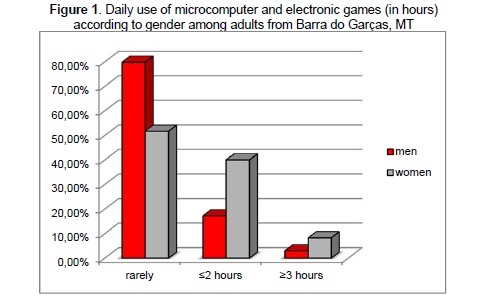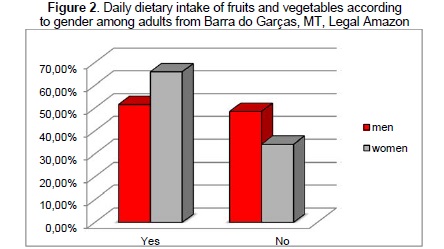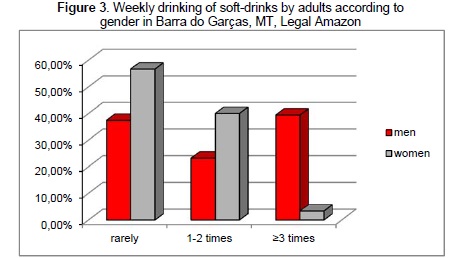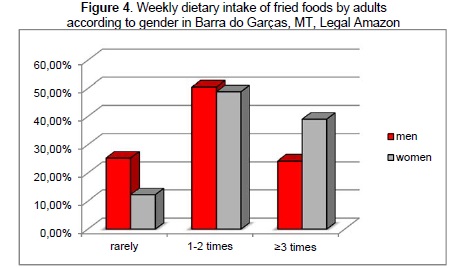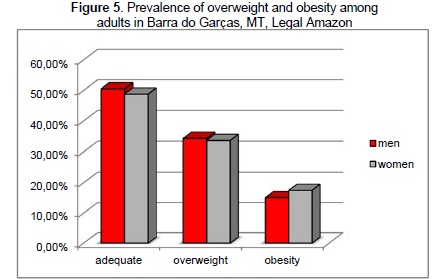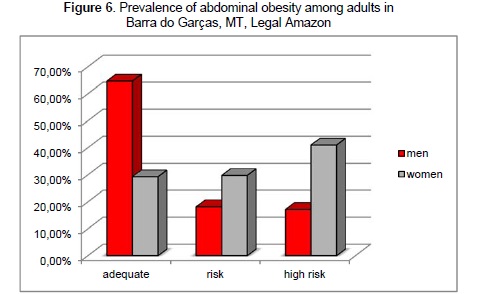Services on Demand
Journal
Article
Indicators
-
 Cited by SciELO
Cited by SciELO -
 Access statistics
Access statistics
Related links
-
 Cited by Google
Cited by Google -
 Similars in
SciELO
Similars in
SciELO -
 Similars in Google
Similars in Google
Share
Revista de Salud Pública
Print version ISSN 0124-0064
Rev. salud pública vol.18 no.1 Bogotá Jan./Feb. 2016
https://doi.org/10.15446/rsap.v18n1.30570
Obesity and lifestyle risk factors among an adult population in Legal Amazon, Mato Grosso, Brazil
Obesidad y estilo de vida en una población adulta en la Amazonia Legal, Mato Grosso, Brasil
Rita de Cássia Spanhol1 and Carlos Kusano Bucalen-Ferrari2
1 Coordenação de Educação em Saúde, Distrito Sanitário Especial Indígena (DSEI), Cuiabá, MT, Amazônia Legal. Instituto de Ciências Biológicas e da Saúde (ICBS), Campus Universitário do Araguaia, Universidade Federal de Mato Grosso (UFMT). Brasil. enf.ritacs@hotmail.com
2 Universidade Federal da Integração Latinoamericana (UNILA). Instituto de Ciências Biológicas e da Saúde (ICBS), Campus Universitário do Araguaia, Universidade Federal de Mato Grosso (UFMT), Brasil. ferrariphd@yahoo.com.br
Received 6th July 2012/Sent for Modification 23th January 2014/Accepted 4th June 2015
ABSTRACT
Objective To evaluate the frequency of obesity and lifestyle risk factors in the population of Barra do Garças, Legal Amazon.
Methodology A randomized, transversal study with 305 adults of both genders was performed. Weight, height, body mass index (BMI), waist circumference, food dietary habits, frequency of smoking and alcoholic consumption, practice of physical activity, and thrfd4e physical activity level were evaluated.
Results Smoking and alcoholic consumption was higher among men compared to women. Almost 60 % of men engaged in leisure-time physical activities, whereas only 42.4 % of women practiced physical activity. Women were engaged in mostly sedentary behavior activities, such as watching television and using the computer use than men. Dietary daily intake of fruits and vegetables were higher among women compared to men (65.9 % and 51.5 %, respectively). Men were more prone to drink soft drinks than women. However, 39.4 % of men and only 3.4 % of women drank soft drinks three or more days per week. The prevalence of overweight and obesity according to body mass index (BMI) was higher in this study. 34.4 % of men and 33.7 % of women were overweight and 15.10 % and 17.50% of men and women, respectively, were classified as obese. Elevated values of waist circumference were found in 35.35 % of men and 70.73 % of women.
Conclusion Women were more sedentary than men and had higher prevalence of abnormal waist circumference values.
Key Words: Waist circumference, obesity, adult, women's health (source: MeSH, NLM).
RESUMEN
Objectivo Evaluar la frecuencia de obesidad y factores de riesgo del estilo de vida, en la población de Barra do Garças, Amazônia Legal.
Metodología Se realizó un estudio transversal con 305 adultos de ambos sexos, seleccionados al azar. Se evaluaron el peso corporal, estatura, índice de masa corporal (IMC), circunferencia de la cadera, hábitos alimentarios, frecuencia del tabaquismo, ingestión de alcohol y el nivel de actividad física.
Resultados La frecuencia del tabaquismo y de la ingestión de bebidas alcohólicas fue mayor entre los hombres en comparación con las mujeres. Alrededor del 60 % de los hombres realizaban actividades físicas durante el tiempo libre, mientras que sólo el 42,4 % de las mujeres lo hizo. Las mujeres estaban más ocupadas en actividades sedentarias como ver televisión y el uso de computadora que los hombres. La ingesta diaria de frutas y verduras fue mayor en mujeres que en hombres (65,9 % y 51,5 %, respectivamente). Los hombres fueron más propensos a consumir refrescos que las mujeres (40 % de las mujeres y 23,2 % de los hombres consumian refrescos una o dos veces a la semana). Sin embargo, el 39,4 % de los hombres y sólo el 3,4 % de las mujeres ingirieron refrescos tres o más veces por semana. La prevalencia de sobrepeso y obesidad, según el IMC, resultó alta en este estudio. Un 34,4 % de los hombres y el 33,7 % de las mujeres tenían sobrepeso; el 15,1 % y el 17,5 % de los hombres y mujeres, respectivamente, fueron clasificados como obesos. Se encontraron valores excesivos de circunferencia de la cadera en 35,4 % y 70,7 % de los hombres y de las mujeres, respectivamente.
Conclusión El sedentarismo y la prevalencia de valores excesivos de circunferencia de la cadera fueran mayores en las mujeres.
Palabras Clave: Circunferencia de la cadera, obesidad, adulto, salud de la mujer (fuente: DeCS, BIREME).
Adequate dietary habits, regular practice of physical activities and avoidance of stressful situations are important components of a healthy lifestyle that are associated with decreased risk of overweight, obesity and its comorbidities (1-3). Nonetheless, sleeping problems, sedentary behavior (or physical inactivity), and lacking of leisure time, allied to a lower intake of fruits, vegetables, cereals, and fibers, as well as higher intake of fatty, fried and caloric foods, snacks, and soft-drinks have been associated with increased overweight and obesity risk in children and adults (3-7).
In the United States (US), the prevalence of obesity among adults is 33.80 %, and the overall prevalence of overweight and obesity is 68.0 %, 72.3 % among men, and 64.1 % among women (8). In Brazil, the prevalence of adult excessive body weight is 47.0 % for men and 39.0 % for women, and obesity prevalence reached 11.0 % for both genders (7). Furthermore, obesity has been also implicated in many important co-morbities such as hypertension, stroke, type 2 Diabetes mellitus, metabolic syndrome, chronic kidney disease, and some cancer types (6,9,10).
The objective of this work was to evaluate obesity and its associated lifestyle factors among a representative sample of adults from "Vale do Araguaia", Legal Amazon, Brazil.
METHODOLOGY
We developed a descriptive transversal study in the Barra do Garças municipality. Over the course of four weeks, 99 adult men and 205 adult women were randomly selected in two supermarkets and two banks.
The inclusion criteria were agreement to engage into the research as well as capacity of understanding the questionnaire. Those people who did not agree to join the study were excluded.
The instrument included lifestyle factors according to the diabetes score risk (alcohol drinking, smoking, regular practice of physical activities, engagement on sedentary behavior activities such as television watching and use of microcomputer) and a food frequency questionnaire including the most frequent food groups and also unhealthy junk foods (11,12).
For characterization of overweight and obesity the body mass index (BMI=body mass (in kg)/height2 [in meters]) and the waist circumference (measured at the mean point between the last rib and the iliac crest) were measured with anthropometric tape (Sanny, model SN-4010, USA) and weight scale (Tanita, model TBF551, Japan).
Measurements were taken individually in a reserved room in each health unit, preserving the privacy of each study participant. The study was conducted in August and October 2011.
All participants received adequate information regarding the study's procedures and signed the free and clarified term and the study protocol that was approved by the ethical commitee on research of the "Hospital Universitário Júlio Müller" (Protocol no. 665/CEP-HUJM/09).
RESULTS
Smoking frequency was higher among men compared to women (22.2 % and 16.1 %, respectively). Still in this respect, 12.0 % of men and only 1.95 % of women smoked more than one cigarette pack per day.
In terms of alcohol consumption, men also drank more than women (39.4 % and 30.2 %, respectively). In this regard, 13.1 % of men and 3.9 % of women were found to consume alcohol three or more days per week. The overall prevalence of alcoholic beverage consumption was 33.2 % in the sample.
Almost 60.0 % of men were engaged on leisure-time physical activities, whereas only 42.4 % of women reported to practice physical activity.
Women appeared to be involved in more weekly leisure activities (dancing, singing and other) than men. However, they were engaged in most sedentary behavior activities, such as television watching and use of microcomputer (electronic games), than men (Figure 1).
Dietary daily intake of fruits and vegetables were higher among women compared to men (65.9 % and 51.5 %, respectively) (Figure 2).
Men were more prone to drink soft drinks than women. 40.0 % of women and 23.2 % of men were found to drink soft drinks one or two days per week. However, 39.4 % of men and only 3.40 % of women drank soft drinks three or more days per week (Figure 3).
The weekly dietary intake of sweets and candies were equally distributed among men and women. The dietary intake of one or two days per week was 35.4 and 34.6 %, respectively among men and women. Women were more prone to consume sweets and candies three or more days per week than men (11.1 % and 15.1 %, respectively).
Fried foods were regularly consumed during one or two days per week, and women consumed those foods more than men (Figure 4).
The prevalence of overweight and obesity was higher in this study. 34.40 % of men and 33.7 % of women were overweight and 15.1 % and 17.5 % of men and women, respectively, were classified as obese according to BMI (Figure 5).
Nevertheless, considering waist circumference, women had increased cardiovascular, cerebrovascular, and metabolic risk than men (Figure 6).
DISCUSSION
In this study, 22.2 % of men and 16.1 % of women were current smokers, which is in agreement with a study from Argentina (13). In a recent study within a small Brazilian city (14) the prevalence of smoking among men was similar to that found in the present study, whereas fewer women smoked (10.30 %) than in the current study. Considering alcohol consumption, the prevalence found in the present study (33.2 %) was higher than that reported by other authors in Brazil (15,16).
The prevalence of excessive body weight (overweight and obesity) according to body mass index was higher in this study (50.4 %). Analysing waist circumference values, women had increased cardiovascular, cerebrovascular, and metabolic risk than men. These results were similar to those found in a representative sample of adults from Sao Leopoldo, Rio Grande do Sul State (RS), Brazil (17). The excessive body weight in 26 Brazilian State capitals and in the Federal District was 44.4 % (49.6 % among men and 39.7 % among women) (18). However a probabilistic population study of adults in Lages, Santa Catarina State (SC), Brazil, found a prevalence of excessive body weight of almost 57.0 % (19).
Considering waist circumference values, women had increased cardiovascular, cerebrovascular, and metabolic risk than men. In this study, elevated values of waist circumference were found; 35.4 % of men and 70.7 % of women had increased waist circumference values. In the study of Longo et al. (19) 19.5 % of men and 59.1 % of women had increased waist circumference values. Waist circumference is a good predictor of both insulin sensitivity and high density cholesterol (HDL) levels (20,21).
In this study the dietary intake of fruits and vegetables was higher (61.2 %) than that reported by Figueiredo et al (22).
In the current study, daily dietary intake of fruits and vegetables for men (51.5 %) was higher than that reported by Coca et al (15) in Dourados city (40.0 %), Brazil, whereas it was similar among women in both studies. In a population-based study covering adults with 30 years of age or more in Ribeirao Preto, Sao Paulo State (SP), Brazil, women ate more fruits and vegetables than men (23), which corroborates data from this study.
Excessive intake of fats and fried foods had been associated with increased risk of obesity and the metabolic syndrome according to Brazilian, Spanish, and US studies (3,5,7,8,24).
In this study, the dietary intake of fried and salted foods of three or more days per week was higher among women (39.00 %) compared to men (24.20 %).
In the present work, the dietary intake of sweets and candies three or more days per week was lower when compared to other studies in Los Angeles and Louisiana, USA, and in SP, Brazil (25, 26).
Consumption of soft drinks three or more days per week was higher for men than for women. Regular drinking of soft drinks strongly increases the risk of obesity, type 2 diabetes mellitus, metabolic syndrome, and cardiovascular disease (27,28).
In the present study, only 60.0 % of men and 42.4 % of women were involved in regular practice of physical activities during their leisure times. In a population-based study of 2 732 adults from Pelotas (RS), Brazil, sedentary behavior was the most prevalent cardiovascular risk factor (75.6 %) (29). Women were engaged in most sedentary behavior activities, such as television watching and use of microcomputer than men. Sedentary behavior, especially watching television, has been linked to increased frequency of daily consumption of soft drinks and dietary intake of snacks, fast foods, and high-energy foods (30,31). Television watching has been associated with increased risk of cardiovascular disease, type 2 diabetes mellitus, and all-cause mortality (32). Lower levels of physical activity are associated with an increased risk of breast, colon, uterine, and other cancers (33). Furthermore, regular practice of physical exercise also helps to decrease the risk of depression and affective disorders, type 2 diabetes mellitus, obesity, metabolic syndrome and osteoporosis (1-6,34).
In this study, more men were engaged on leisure-time physical activity than women. On the other hand, women were more prone to perform sedentary activities but they had more adequate eating habits than men. Half of the people had excessive body weight and one third of men and 70% of women had abdominal obesity •
REFERENCES
1. Church TS, LaMonte MJ, Barlow CE, Blair SN. Cardiorespiratory fitness and body mass index as predictors of cardiovascular disease mortality among men with diabetes. Arch Intern Med. 2005;165:2114-2120. [ Links ]
2. Ferrari CKB. Functional foods and physical activities in health promotion of aging people. Maturitas. 2007;58:327-339. [ Links ]
3. Rodríguez-Rodríguez E, Ortega Anta RM, Palmeros-Exsome C, López-Sobaler AM. Factores que contribuyen al desarrollo de sobrepeso y obesidad en población adulta española. Nutr Clin Diet Hosp. 2011;31(1):39-49. [ Links ]
4. Hu FB, Li TY, Colditz GA, Willett WC, Manson JE. Television watching and other sedentary behaviors in relation to risk of obesity and type 2 diabetes mellitus in women. JAMA. 2003;289: 1785-1791. [ Links ]
5. Ferrari CKB. Metabolic syndrome and Obesity: Epidemiology and prevention by physical activity and exercise. J Exerc Sci Fit. 2008; 6(2):87-96. [ Links ]
6. Gigante DP, Moura EC, Sardinha LMV. Prevalence of overweight and obesity and associated factors, Brazil, 2006. Rev Saude Publica. 2009; 43(suppl.2):83-9. [ Links ]
7. Guallar-Castillón P, Rodríguez-Artalejo F, Fornés NS, Banegas JR, Etxezarreta PA, Ardanaz E, et al. Intake of fried foods is associated with obesity in the cohort of Spanish adults from European Prospective investigation into cancer and nutrition. Am J Clin Nutr. 2007;86:198-205. [ Links ]
8. Flegal KM, Carroll MD, Ogden CL, Curtin LR. Prevalence and trends in obesity among US adults, 1999-2008. JAMA. 2010; 303(3):235-41. [ Links ]
9. Charneco E, Ortiz AP, Venegas-Ríos HL, Romaguera J, Umpierre S. Clinic-based case-control study of the association between body mass index and endometrial cancer in Puerto Rican women. P R Health Sci J. 2010; 29(3):272-8. [ Links ]
10. Valocikova I, Valocik G, Kristofova B, Druzbacka L. Obesity paradox and chronic kidney disease. Bratisl Lek Listy. 2011;112(7):402-6. [ Links ]
11. Vieira VCR, Priore SE, Ribeiro SMR, Franceschini S do CC, Almeida LP. Socioeconomic, nutritional and health profile of adolescents recently admitted to a Brazilian public university. Rev Nutr. 2002;15:273-282. [ Links ]
12. Saaristo T, Peltonen M, Lindström J, Saarikoski L, Sundvall J, Erikson JG, et al. Crosssectional evaluation of the Finnish diabetes risk score: a tool to identify undetected type 2 diabetes, abnormal glucose tolerance and metabolic syndrome. Diabet Vasc Dis Res. 2005;2:67-72. [ Links ]
13. Martínez E, Kaplan CP, Guil V, Gregorich SE, Mejia R, Pérez-Stable EJ. Smoking behavior and demographic risk factors in Argentina: a population-based survey. Prev Contr. 2006;2:187-97. [ Links ]
14. Yokota RTC, Iser BPM, Andrade RLM, dos Santos J, Meiners MMM, Assis DM, et al. Vigilância de fatores de risco e proteção para doenças e agravos não transmissíveis em município de pequeno porte, Brasil, 2010. Epidemiol Serv Saúde. 2012;21(1): 55-68. [ Links ]
15. Souza REB, Oliveira FE, Cavatti LS, Broedel P, Armani SC, Lenz D, et al. Perfil nutricional de pacientes acompanhados pelo Programa Hiperdia em uma unidade de estratégia da família de Vila Velha-ES. Ceres Nutr Saude. 2011;6(3):139-150. [ Links ]
16. Coca AL, Gripp DB, Shinestzki ECV, Gianlupi K, Liberali R, Coutinho VF. Consumo alimentar e sua influência no controle da hipertensão arterial de adultos e idosos de ambos os sexos em uma unidade básica de saúde em Dourados-MS. Rev Bras Cienc Envelhec Hum. 2010;7(2):244-257. [ Links ]
17. Backes V, Olinto MTA, Henn RL, Cremonese C, Pattussi MP. Associação entre aspectos psicossociais e excesso de peso referido em adultos de um município de médio porte do Sul do Brasil. Cad Saude Publica. 2011;27(3):573-580. [ Links ]
18. Sá NNB de, Moura EC. Excesso de peso: determinantes sociodemográficos e comportamentais em adultos, Brasil, 2008. Cad Saude Publica. 2011;27(7):1380-1392. [ Links ]
19. Longo GZ, Neves J das, Castro TG de, Pedroso MR de O, Matos IB. Prevalência e distribuição dos fatores de risco para doenças crônicas não transmissíveis entre adultos da cidade de Lages (SC), sul do Brasil, 2007. Rev Bras Epidemiol. 2011;14(4):698-708. [ Links ]
20. Matos LN, Giorelli G de V, Dias CB. Correlação dos indicadores antropométricos em identificar a sensibilidade e resistência insulínicas. Sao Paulo Med J. 2011;129(1):30-35. [ Links ]
21. Arimura ST, Moura BM, Pimentel GD, Silva MER, Souza MV. Waist circumference is better associated with high density lipoprotein (HDL-c) than with body mass index (BMI) in adults with metabolic syndrome. Nutr Hosp. 2011;26 (6):1328-1332. [ Links ]
22. Figueiredo ICR, Jaime PC, Monteiro CA. Factors associated with fruit and vegetable intake among adults of the city of Sao Paulo, Southeastern Brazil. Rev Saude Publica. 2008;42:777-785. [ Links ]
23. Mondini L, Moraes SA, Freitas ICM, Gimeno SGA. Consumo de frutas e hortaliças por adultos em Ribeirão Preto, SP. Rev Saude Publica. 2010;44(4):686-694. [ Links ]
24. Freire RD, Cardoso MA, Gimeno SGA, Ferreira SRG. Dietary fat is associated with metabolic syndrome in Japanese Brazilians. Diab Care. 2005;28:1779-1785. [ Links ]
25. Ferrari CKB, Guimarães CF, Honorio-França AC, França EL. Health and quality of life among workers from a great food supplier company in Sao Paulo (SP), Brazil. Middle East J Sci Res. 2011;7(4):543-549. [ Links ]
26. Cohen DA, Sturm R, Scott M, Farle TA, Bluthenthal R. Not enough fruits and vegetables or too many cookies, candies, salty snacks and soft drinks? Public Health Rep. 2010;125(1):88-95. [ Links ]
27. Malik VS, Popkin BM, Bray GA, Després J-P, Hu FB. Sugar-sweetened beverages, obesity, type 2 diabetes mellitus, and cardiovascular disease risk. Circulation. 2010;121:1356-1364. [ Links ]
28. Malik VS, Popkin BM, Bray GA, Després J-P, Willett WC, Hu FB. Sugar-sweetened beverages and risk of metabolic syndrome and type 2 diabetes: a meta-analysis. Diabet Care. 2010;33:2477-2483. [ Links ]
29. Muniz LC, Schneider BC, da Silva ICM, Matijasevich A, Santos IS. Fatores de risco comportamentais acumulados para doenças cardiovasculares no sul do Brasil. Rev Saúde Publica. 2012;46(3):534-542. [ Links ]
30. Rehm CD, Matte TD, Van Wye G, Young C, Frieden TR. Demographic and behavioral factors associated with daily sugar-sweetened soda consumption in New York City adults. J Urban Health. 2008;85:375-385. [ Links ]
31. Pearson N, Biddle SJH. Sedentary behavior, and dietary intake in children, adolescents, and adults: a systematic review. Am J Prev Med. 2011;41(2):178-188. [ Links ]
32. Grøntved A, Hu FB. Television viewing and risk of type 2 diabetes, cardiovascular disease, and all-cause mortality. JAMA. 2011;305(23):2448-2455. [ Links ]
33 Parkin DM. Cancers attributable to inadequate physical exercise in the UK in 2010. Brit J Canc. 2011;105 (Suppl.2):S38-S41. [ Links ]
34. Dunn AL, Trivedi MH, Kampert JB, Clark CG, Chambliss HO. Exercise treatment for depression. Efficacy and dose response. Am J Prev Med. 2005;28:1-8. [ Links ]
35. Ma H, Leskinen T, Alen M, Cheng S, Sipila S, Heinonen A, et al. Long-term leisure time physical activity and properties of bone: a twin study. Bone. 2009;44 (suppl.2):S343. [ Links ]













